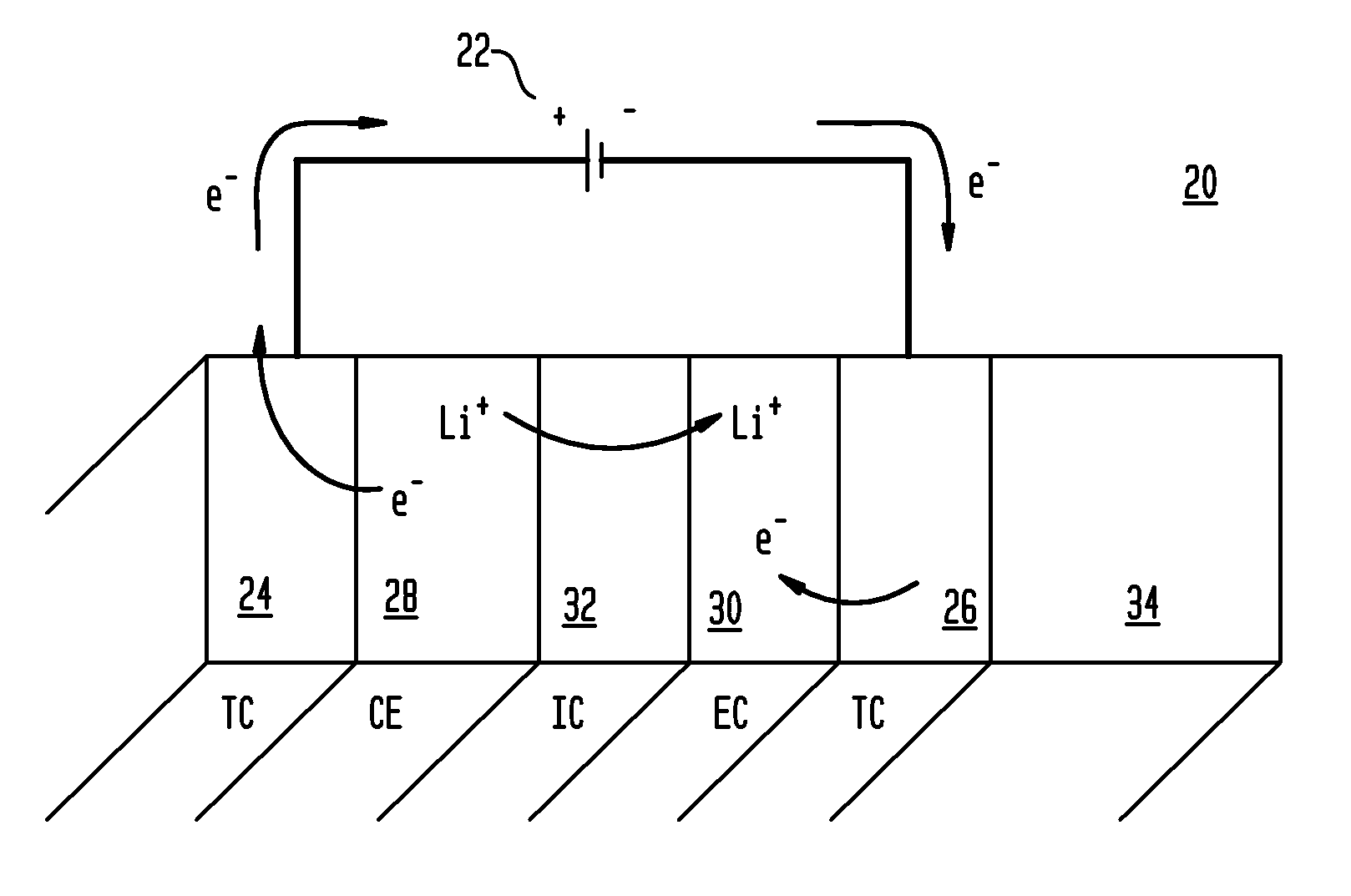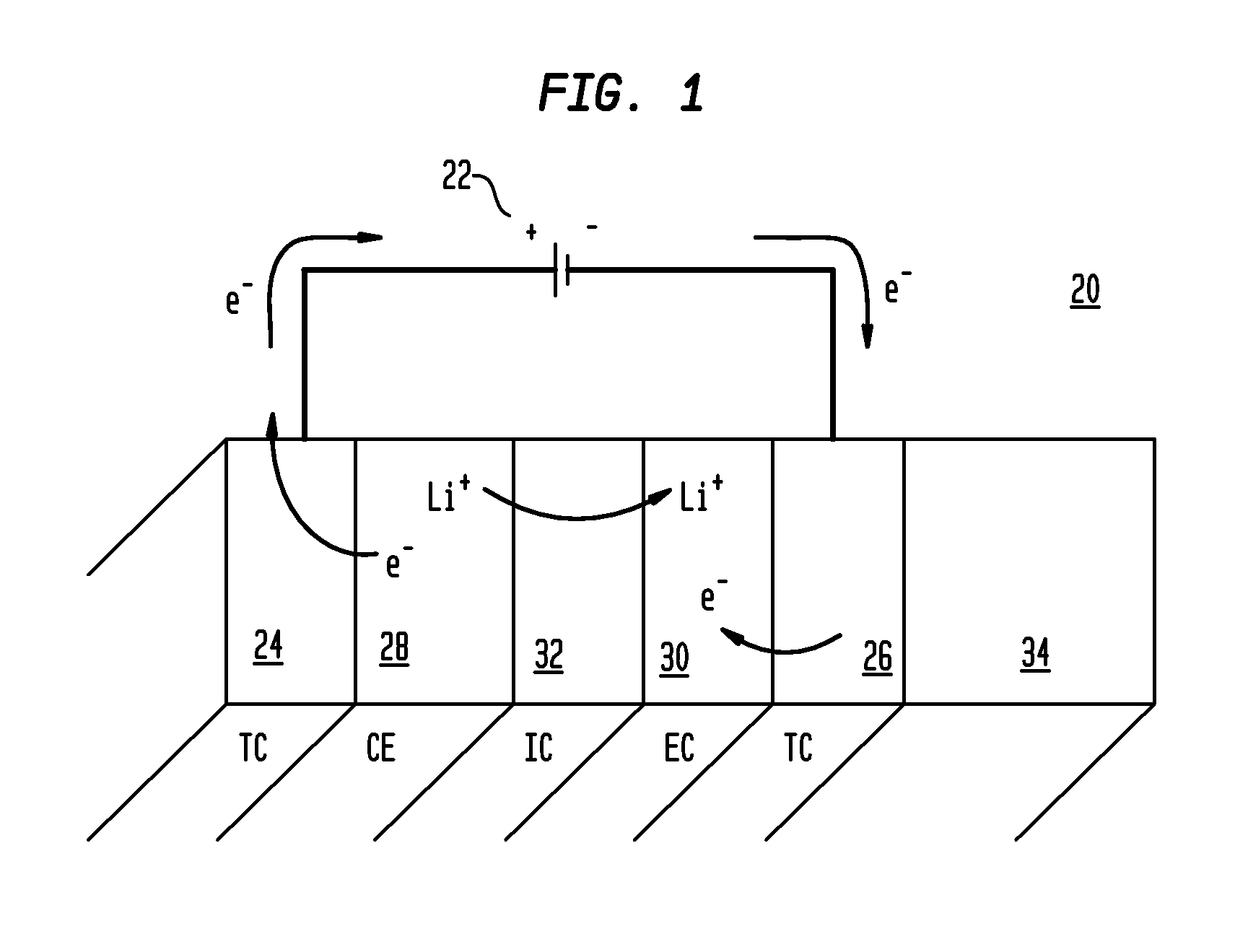Electrochromic nickel oxide simultaneously doped with lithium and a metal dopant
a nickel oxide and lithium technology, applied in the field of electrochromic materials, can solve the problems of undesirable side reactions, difficult intercalation of lithium into nio based materials, and how dark an electrochromic device can becom
- Summary
- Abstract
- Description
- Claims
- Application Information
AI Technical Summary
Benefits of technology
Problems solved by technology
Method used
Image
Examples
example 1
[0127]Structural characterization results for the as-deposited Li2.34NiZr0.28Ox films prepared by RF magnetron sputtering are shown in FIG. 2. Cross-sectional scanning electron microscopy (SEM) image (FIG. 2a) shows the film thickness is ca. 80 nm, which is thinner than reported nickel oxide-based anodic electrodes.
[0128]FIG. 2b provides the X-ray diffraction (XRD) spectrum for the as-deposited Li2.34NiZr0.28Ox film. Only the (200) peak is observed in the spectrum indicating that nickel oxide nanocrytallites were preferentially oriented along the direction. Additionally, the diffraction angle (2θ=42.5°) was shifted towards a lower value relative to the face center cubic NiO indicating that the lattice constant of the nickel oxide-based material is expanded due to the doping of Zr and Li in the lattice.
[0129]High-resolution transmission electron microscopy (HRTEM) image is shown in FIG. 2c. Nickel oxide nanocrytallites were believed to be imbedded in an amorphous matrix, which is si...
example 2
[0130]X-ray absorption spectroscopy (XAS) was employed to investigate the Li and Zr co-doping effects on the electronic structure of nickel oxide. FIG. 3 presents a comparison of the Ni L-edge XAS for several nickel oxide-based thin films, corresponding to dipole transitions from Ni 2p to Ni 3d states, including both the 2p3 / 2 (LIII) and 2p1 / 2 (LII) spin-orbit final states. Due to the direct dipole transition from 2p to 3d orbitals and the high resolution in the soft x-ray regime, L-edge XAS of transition metals is sensitive not only to the valency of the metal, but also to the detailed energetics of the ligand-3d interactions governed in particular by symmetry, as well as spin and hybridization.
[0131]Although rigorous treatment of all possible final states can be complicated, the most salient features of the transition metal L-edge can be captured by atomic calculations by the introduction of crystal field effects. It is believed that the XAS spectrum for a NiOx film produced by RF...
example 3
[0132]
Specific optical density=ln (% Tb / % Tc) / thickness Eq. (1)
[0133]Cyclic voltammetry and in-situ transmittance curves for Li2.34NiZr0.28Ox and Li1.81NiW0.21Ox thin film electrodes cycled in a 1 M LiClO4 dissolved in propylene carbonate are shown in FIGS. 7a and 7b. The charge capacities (determined from the CVs) are 21.8 mC / cm2 and 21.4 mC / cm2 for the Li2.34NiZr0.28Ox and Li1.81NiW0.21Ox electrodes, respectively. The charge capacities for Li2.34NiZr0.28Ox and Li1.81NiW0.21Ox, it is believed, could be controlled (modified) easily by varying the film thickness. The in-situ optical modulation at about 670 nm for the Li2.34NiZr0.28Ox film was about 45% compared to about 35% for the Li1.81NiW0.21Ox film. As determined by Eq. (1), the high specific optical density (defined as the optical density per micrometer) for the Li2.34NiZr0.28Ox film (8.1 μm−1) was comparable to that of the state-of-the-art porous WO3 film (9.0 μm−1). Without wishing to be bound by any particular theory, it is...
PUM
| Property | Measurement | Unit |
|---|---|---|
| Thickness | aaaaa | aaaaa |
| Thickness | aaaaa | aaaaa |
| Thickness | aaaaa | aaaaa |
Abstract
Description
Claims
Application Information
 Login to View More
Login to View More - R&D
- Intellectual Property
- Life Sciences
- Materials
- Tech Scout
- Unparalleled Data Quality
- Higher Quality Content
- 60% Fewer Hallucinations
Browse by: Latest US Patents, China's latest patents, Technical Efficacy Thesaurus, Application Domain, Technology Topic, Popular Technical Reports.
© 2025 PatSnap. All rights reserved.Legal|Privacy policy|Modern Slavery Act Transparency Statement|Sitemap|About US| Contact US: help@patsnap.com



